| 1 | Emerald tree boa |
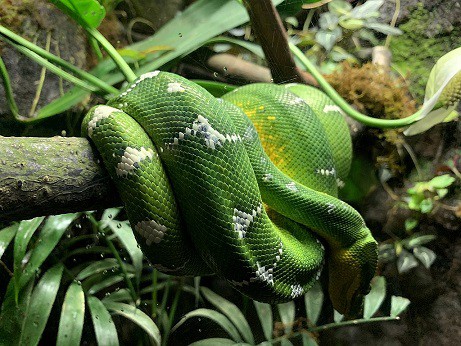
The emerald tree boa is renowned for having one of the slowest metabolisms among snakes, going months between meals with ease. This is a true rainforest snake, which curls around branches without moving, and almost never strays into neighbouring cocoa or banana fields. They live in Brazil, Suriname, French Guiana, and Guyana, and are creatures of moistness, which only appear in areas with over 1500mm of rain per year.
This is an ambush predator, whose colours are geared completely towards disguise. That means green to blend into the dense Amazon foliage, and white to mimic small beams of light shining through the high canopies. They reach a record of 210.8cm, and their front fangs are extremely brutal, designed for gripping prey before constriction.
Emerald tree boas sticks to greenness throughout its empire, but there’s subtle variations. The Amazon basin further south hosts a version with extra white markings, which sometimes fuse to form unbroken white lines. In northern Peru, there’s a significantly darker green colony, while still keeping the bright white marks. The “main” version pictured most commonly lives in the Guiana shield further north.
| 2 | Green tree python |
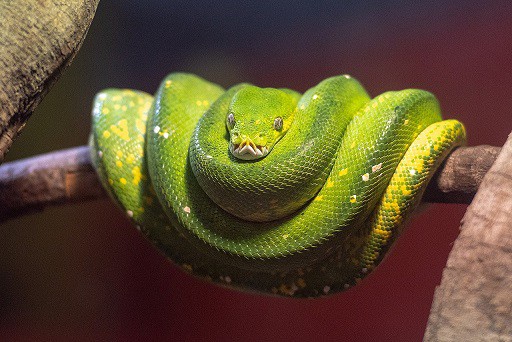
This unrelated Australian species looks extremely similar to the emerald tree boa, even down to the resting branch method of placing its head comfortably in a nest of coils. In the international pet trade, where both are popular, these hyper-green snakes are often confused.
The green tree python reach lengths of 220cm, with a relatively thin body for a python. Their diet mostly consists of rodents, and their head is extremely large. The green is all consuming, with a handful of perfectly shaped white spots that resemble missing scales. At birth however, they’re a bright banana yellow, with barely a hint of green. It takes several months to attain adult colouring. Those on Biak Island, Indonesia, can take as long as 5 years to achieve full adult greenness. Despite the pet trade demand, green tree pythons remain of “Least concern” worldwide.
In Australia, this snake often overlaps with the carpet python. The two compete for success in the same ecological niche, a constricting ambush snake, but the carpet python is brown instead of green. Time will tell whether greenness proves a decisive factor in the serpent wars.
| 3 | Greater green snake (Ptyas major) |
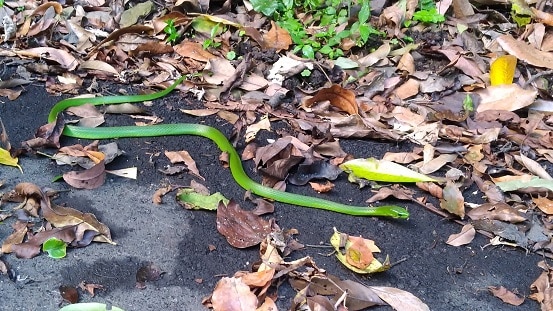
A thin snake with a small head, which can inflict nothing more than a pair of tiny, harmless pinprick wounds. The greater green snake lives in southeast Asia, including Hong Kong and Taiwan, and is less of a tree snake than others. It climbs branches to rest, but is forced to the scour the ground for its main food source: earthworms.
The greater green snake has a mild temperament and usually flees rather than entering the battle fray. Their colour scheme has little colour variation. It’s green, green and more green, with the exceptions of a yellow-green belly and light brown iris. They’re closely related to the oriental ratsnake of Thailand, but green rather than grey.
Alas, the greater green snake seems to have made a big mistake; its greenness is constantly provoking fearful attacks by locals. In Hong Kong, it’s regularly mistaken for the venomous white-lipped green pitviper, while in Taiwan, it’s regularly misidentified as a Chinese tree viper. Both species are just as green, but are differentiated by their vertical pupils. Greater green snakes reach a maximum of 130cm.
| 4 | Green watersnake (South Africa) |
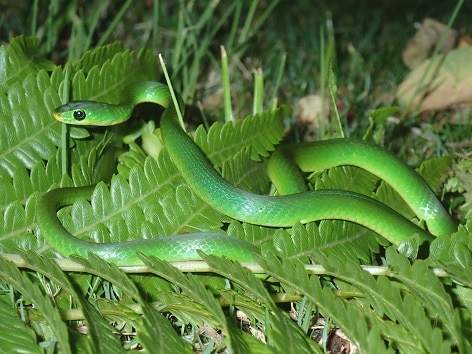
The green watersnake (Philothamnus hoplogaster) is a creature of southeast Africa, including eastern South Africa, Tanzania and Mozambique. They’re a semi aquatic snake which is particularly common in riverside or lakeside bushes. They also have a particular attraction to maize and bean fields.
Philothamnus hoplogaster has a shade of green which is barely distinguishable from riverside vegetation. With their short 50-60cm body size (max 100cm), they’re masters at disguise, who can watch the world go by from clumps of grass without ever being noticed. Green watersnakes prey on frogs, and have smooth scales to touch rather than keeled and rough.
Some local Africans confuse them with the deadly green mamba, but Philothamnus hoplogaster is a harmless, non-venomous snake. As this video proves, an explorer can pick up 5-10 green watersnakes in his fist and have them look nothing more than confused. Green watersnakes are rated as “Least concern” by IUCN, and along well vegetated river shores they can be extremely abundant, with many packed into a few square metres.
| 5 | Common green racer |
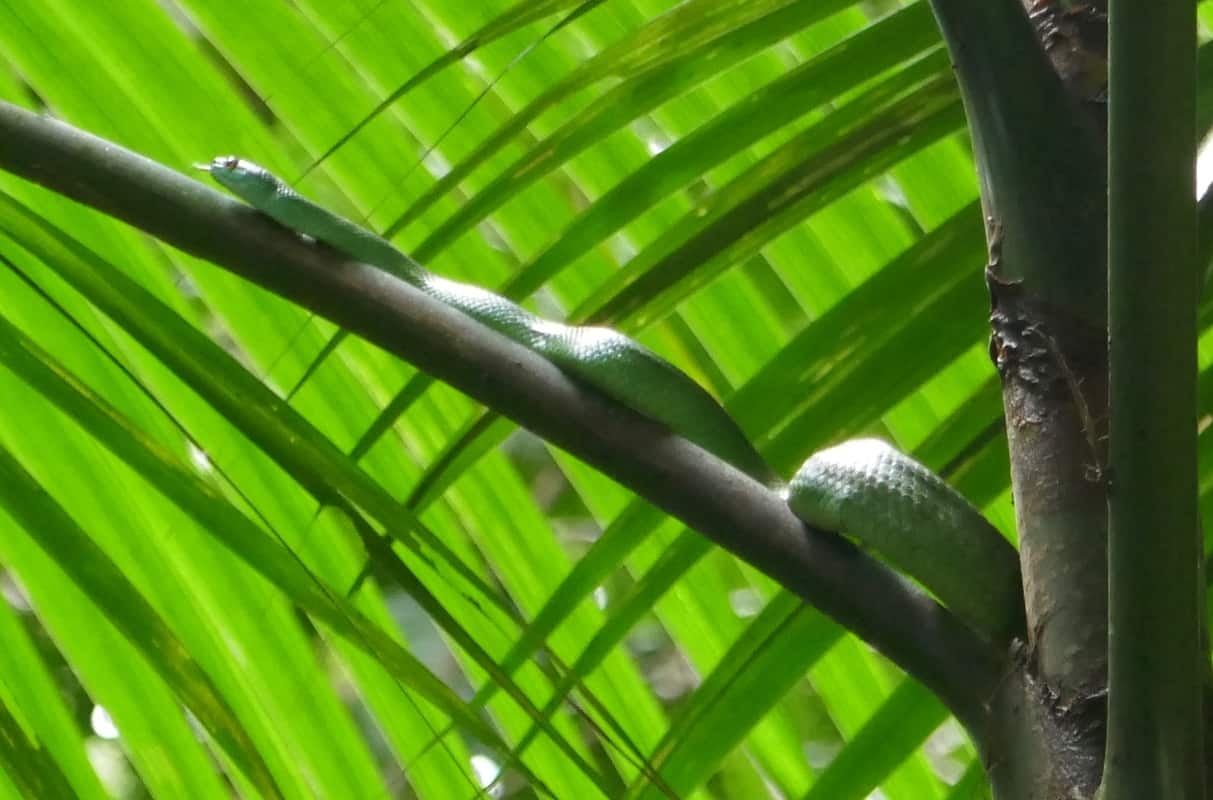
A relative of the long-tailed Chilean racer, but far greener and more tree-dwelling. Chlorosoma viridissimus has a large range in Brazil, Columbia, Paraguay and French Guiana, with new territory discovered all the time. They have the rich foliage colour and long thin tail typical of tree snakes, but are also spotted on the ground. They bask on paved roads at mid-day, and are found lurking in overgrown, disused agricultural areas near villages. They average at 1 metre long (record: 137.6cm), and when threatened they bare their mouth wide, flatten their body, and coil into an S-shape, all while perched delicately on their branches.
There’s an enduring mystery as to how venomous this snake is. A scientist documented a bite in a 2006 report where he grabbed it by the mid-section, and it savagely bit into his arm, twisting so that its rear fangs were penetrating deep. He experienced no symptoms except pain, but a bite in a Virginia pet shop supposedly caused severe swelling and compartmental syndrome, resulting in a deformed arm for the female victim. It’s possible that this second case was a misidentified species. The first story illustrated their excellent green disguise: the Chlorosoma viridissimus was lurking under a bracken fern, but the scientist failed to notice it until it was dashing away.
| 6 | Green cat snake (Boiga cyanea) |
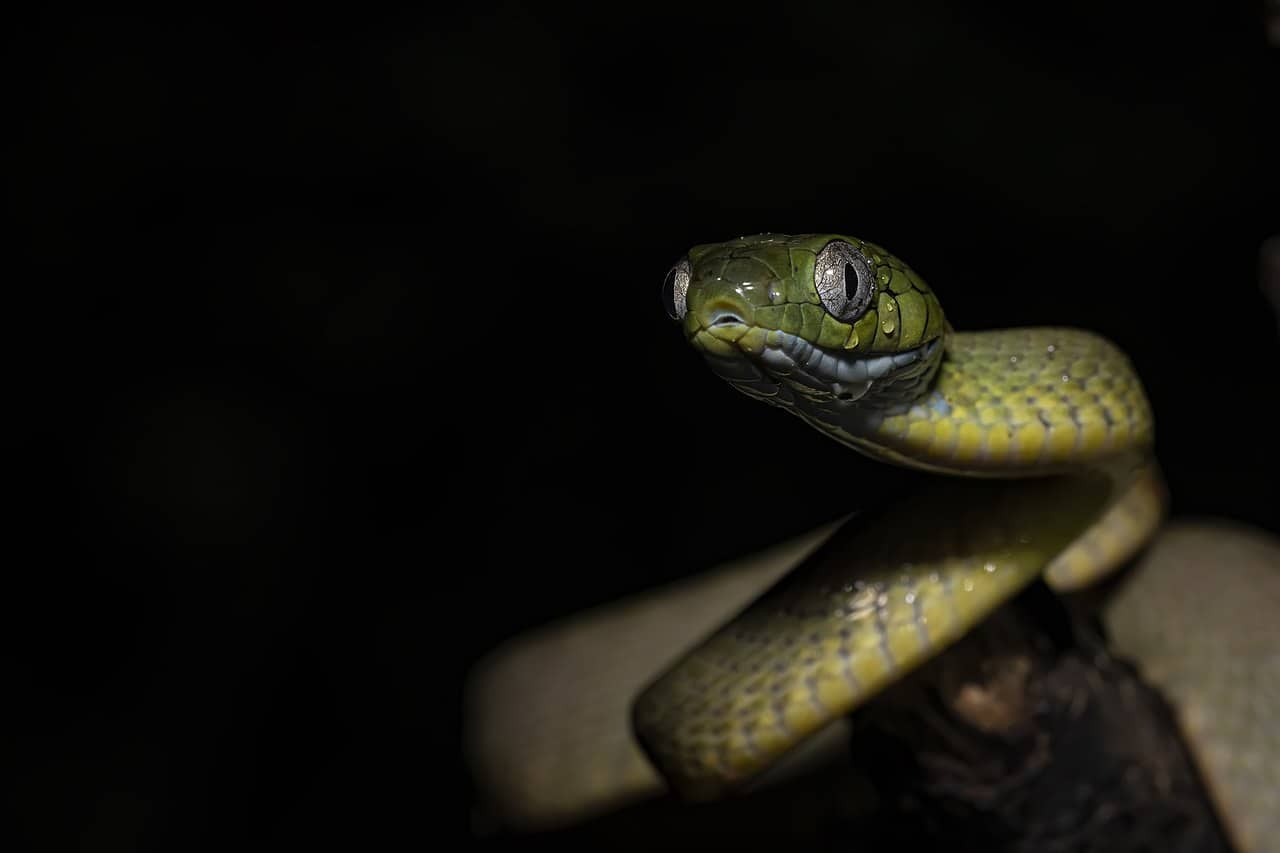
A 150cm (max: 190cm) snake of southeast Asia, and an extremely green one. Green catsnakes are very common in Thailand, but you wont find them within cities like Bangkok, as this is a rural forest snake. They inhabit many types of forest, at up to 2100 metres in altitude.
Against thick Thai forest foliage, Boiga cyanea can be almost invisible, as long as they slither slowly. They use this green camouflage for one wicked purpose – raiding the nests of songbirds. A study from northeast Thailand found that green catsnakes are responsible for 17-33% of all raidings.
There’s few other colours splashed on its body, one being a white-blue chin. Younglings start as red-brown with a green head, which trickles down the body as they age, until achieving full coverage. Green catsnakes also have a black inner mouth, although we don’t recommend getting close enough to have a look. This species lacks front fang venom, but has a mild rear-fanged venom which can cause numbness, tingling and swelling.
| 7 | Rough green snake (USA) |
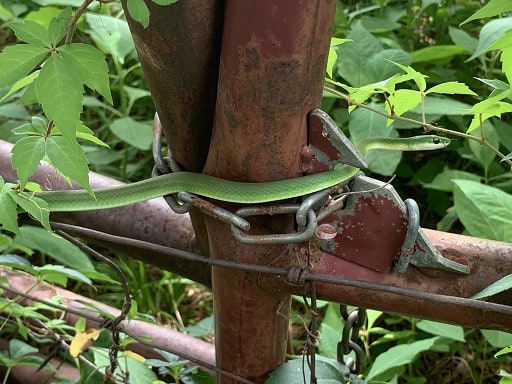
The southern relative of the smooth green snake, which lives across the northeast US and even a swathe of Canada. Rough green snakes stick to the southeast USA, including Indiana, central Texas, and almost all of Florida. Both belong to the Opheodrys family.
Rough green snakes reach high densities in the wild, up to 295 per hectare. Nevertheless, their all-green colour makes them difficult to spot, in the moist vegetation and grass they favour. They’re also extremely thin, so thin that they could probably hide behind a blade of grass if they put their mind to it.
Rough green snakes lack any wacky patterns. They’re neatly divided between a rich green back, and a yellowish belly with strong green tinges. Even their eyes have slight green tinges, surrounding a jet black pupil. Compared to the smooth green snake, its eyes are larger, and it’s longer on average, with a maximum of 116cm. There’s also a signature patch of rough/keeled scales on its back, compared to its consistently smooth northern relative.
This harmless snake is an insect swallower, as studies have found that in hot, dry summers which reduce insect numbers, the rough green snake also decreases.
| 8 | Green bush ratsnake |
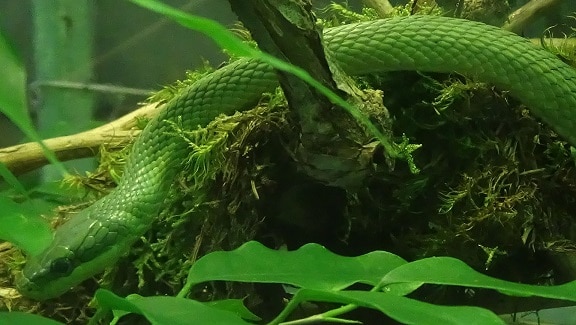
The only place immune from greenness with this species is its mouth and pupils, which are pink and black respectively. The green bush ratsnake (Gonyosoma prasinum) has a large range in southeast Asia, from India through Thailand to the Philippines. Their bodies are a rich grassy green, while their bellies are paler but with constant green tinges.
Green bush ratsnakes reach a record of 135cm. While non-venomous, this tree-dwelling snake is extremely nervous and gets agitated quickly. Reptile keepers have testified that if you bother one in its glass cage playground, it will launch itself into thin air. Another stopped eating for an entire month. This snake is barely researched in the wild (to be fair, there’s 3900 species to cover), but it’s fussy and refuses to eat mice in captivity. It’s more agreeable to rats, but still takes some persuasion. It’s highly likely that this extremely green snake prefers lizards or amphibians.
There’s also chaos with its family. These days, it belongs to the 8 strong Gonyosoma family, but it was first assigned to Coluber, then Elaphe, then Rhadinophis, and finally Gonyosoma. Nobody can make their mind up. In 2021, the green bush ratsnake was separated into two species, the new being G. coeruleum, first discovered in southern China. This new version was equally green, but had blue irises instead of brown, while its mouth was a greyer colour rather than pink. Its belly had less green tinges.
| 9 | Eastern green mamba |
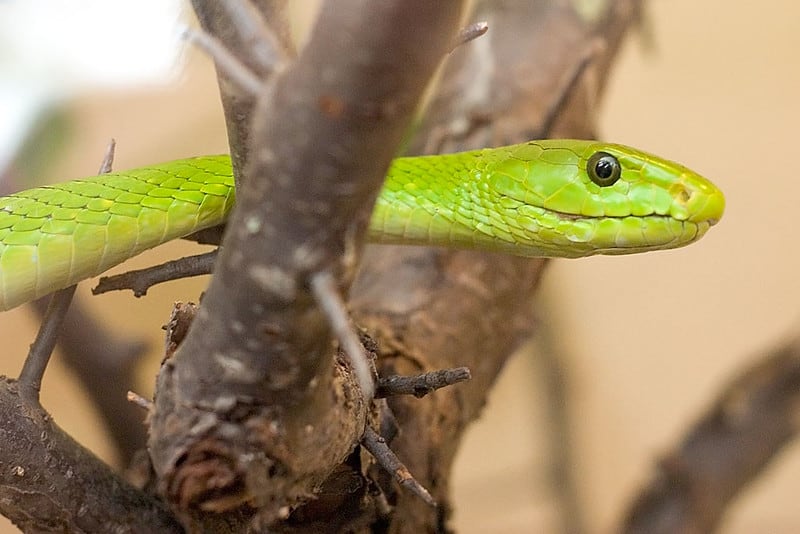
The notorious black mamba (Dendroaspis polylepis) isn’t black, but grey. Its relative the eastern green mamba (Dendroaspis angusticeps) is most definitely green. They have a very similar colour scheme to the US rough green snake – rich green scales with a yellow-green belly. They’re more of a tree-dweller than the adventurous black mamba, although with their large size, they blend in pretty poorly compared to other green serpents.
Green mambas have a female average of 200cm, a male average of 180cm, and a maximum of 250cm. Their eyes are brown, and this species is green from day 1. Hatchlings are merely a slightly different shade, with faint black lines between their scales which gradually fade away.
Green mamba venom is milder than the black mamba’s, and few deaths are recorded. The green mamba lives in its own world, and is far less likely to chase farmers down dusty rural paths. Their range is quite small, merely the southeast coast of Africa. Green mambas have the ability to kill people, they just can’t be bothered, as this would reduce their time slumped blissfully over branches. Green mambas move just 5.4 metres in an average day.
| 10 | Pope’s pitviper (Southeast Asia) |
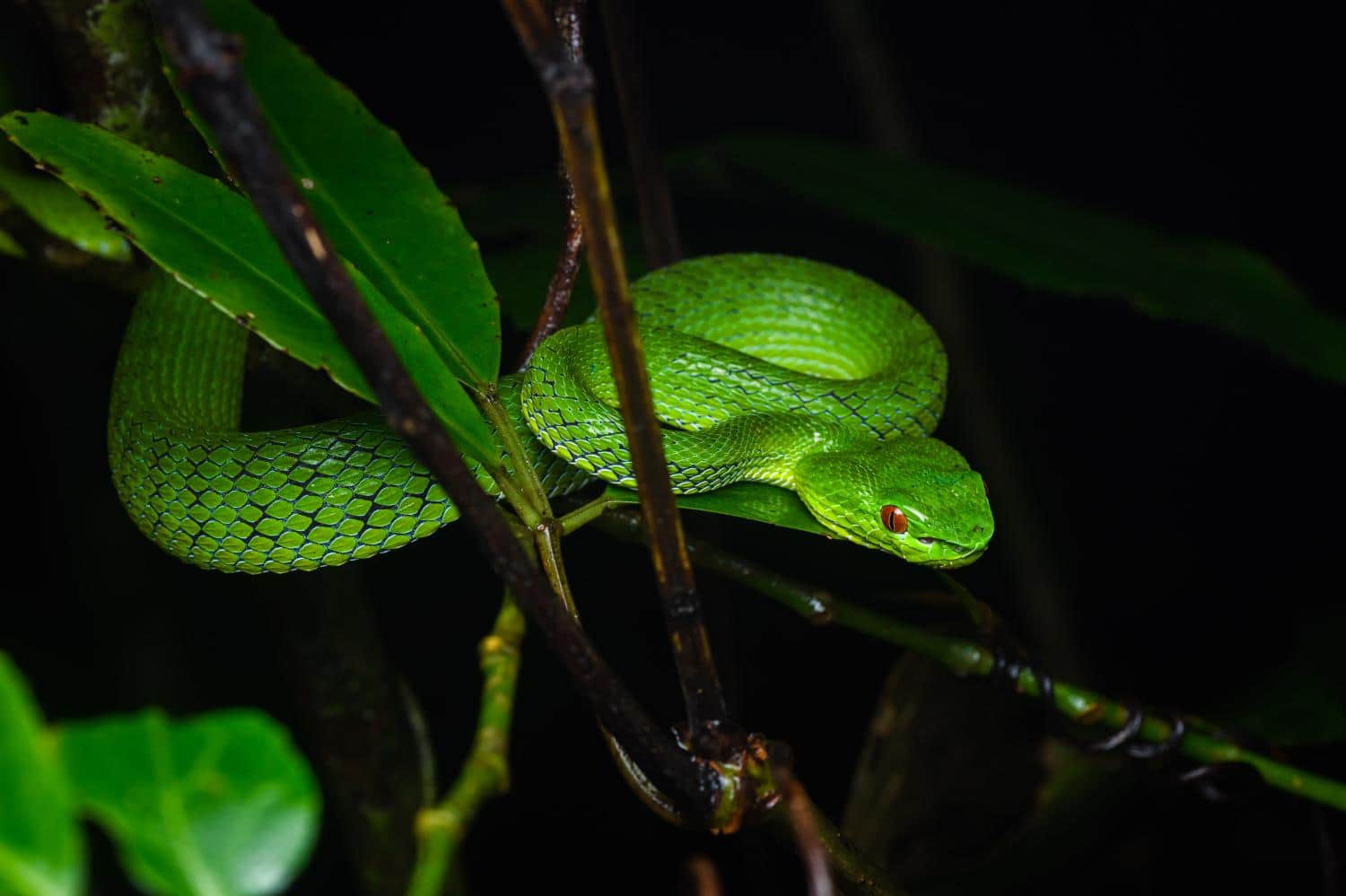
One of the endless green pitviper species in southeast Asia, but the Pope’s pitviper is particularly vivid. This green snake reaches a maximum size of below 1 metre, and sticks to higher altitudes, inhabiting moist forests above 800 metres. It appears most commonly in the wet season, and despite the greenness matching the jungle precisely, it shows up extremely clearly in the glare of torchlight.
Pope’s pitviper is mainly dark green on its back, with a white to pale green belly. The exception is a clear red line that cuts through the middle, extending to a ruby red eye. The red line is bordered by white, before the sea of unrelenting green begins anew. The colours are particularly rich, like a camera turned up to full saturation mode, except that it isn’t.
This green snake lives in Thailand, northeast India, Laos and Myanmar. In Thailand, it primarily inhabits the northwest. Its venom is not to be taken lightly, with strong haemorrhaging properties – the usual trick for the Trimeresurus pitviper family. While they climb trees, they rarely reach towering heights, usually sticking to just above ground or 2 metres in the air.
